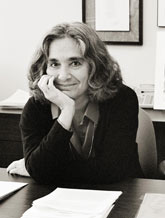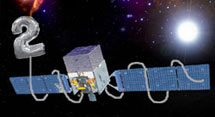

Friday - June 11, 2010
SLAC Today is
available online at:
http://today.slac.stanford.edu
In this issue:
From the Director: LCLS Scores a Hat Trick!
Happy Birthday, Fermi Telescope
Word of the Week: Lightsource
 |
 |
|
Friday - June 11, 2010 |
From the Director: LCLS Scores a Hat Trick! (Photo by Harvey Lynch.)
I've used this title once before despite being sports metaphor challenged… and I've just been reminded that the World Cup starts today (soccer) and that this is a sports term used in hockey (and even I know that hockey is different from soccer). But I do know that it has been a spectacular week for Linac Coherent Light Source, and the success is threefold. Monday, June 7, 3:05 p.m.: First light in Hutch 3! This is a big deal. The X-ray Pump Probe experiment in Hutch 3, which saw first light on Monday, will be the first hard X-ray experiment to operate at LCLS. To date the LCLS has been running experiments with "soft" X-rays of 10-15 Angstrom wavelength. XPP is the first experiment designed to operate with hard X-rays (down to 1.5 Angstrom wavelength). John Arthur had kept me posted on the schedule and I was able to get down to the Near Experimental Hall in time to witness the excitement as the hard X-rays entered the hutch for the first time. It went like clockwork—very impressive! David Fritz, the instrument scientist for XPP, was impressively cool and collected, focused on the measurements they needed to do to get ready for commissioning and then first users in the fall. Read more...  (Image courtesy NASA and Kelen Tuttle.)
Happy Birthday, Fermi TelescopeToday marks the start of the Fermi Gamma-ray Space Telescope's third year in space. Since the spacecraft launched on June 11, 2008, it has completed 10,990 orbits of the Earth at an average altitude of 554 kilometers, for a total of 298 million miles traveled. The Large Area Telescope, the main instrument on the Fermi mission, was managed at SLAC, which also led the development of the electronics and flight software. The LAT has been up and running more than 99 percent of the time since science operations began on August 4, 2008. The LAT has so far recorded more than 22 billion total events, sending more than 11,383 gigabytes of heavily compressed data to Earth for detailed processing at SLAC. These processed data occupy more than 550 terabytes on disk.
The spacecraft carrying the telescope launched from Cape Canaveral June 11, 2008. (Photo courtesy of NASA.)
So far, the LAT collaboration has used more than 533 CPU years processing and analyzing Fermi data. (A CPU year is the amount of processing work a single, modern central processing unit performs during one year of constant operation.) On average, it takes only a few hours for data to be collected onboard the LAT, transmitted to SLAC, processed, and sent on to the Fermi Science Support Center at NASA's Goddard Space Flight Center. The FSSC, which makes these data public, has served over 10,000 retrievals of Fermi data since August 2009. All these data have allowed the LAT collaboration to publish 77 papers (with another 24 papers submitted but not yet published), including five of the top 50 most-cited papers in astronomy, astrophysics and physics in 2009. Happy birthday, Fermi Gamma-ray Space Telescope! Here's to many more. SSRL's SPEAR3 storage ring (lower right) sits a
stone's throw from the entry to the LCLS Undulator Hall
(lower left) and Beam
Transport Hall (long diagonal building) at SLAC.
(Photo by Brad Plummer.) Word of the Week: LightsourceMuch of the springtime buzz around SLAC has been about lightsources. Recently the Stanford Synchrotron Radiation Lightsource gave scientific users new, super-steady beam current with frequent injection mode, while the Linac Coherent Light Source began commissioning its first hard X-ray instrument. Lightsources are intensely bright, tightly-focused sources of X-rays or ultraviolet radiation. These beams are used to study what cannot be seen by the naked eye or even the most advanced microscope. That's because light sources use short wavelengths of light, small enough to reveal the structure of tiny matter such as proteins, viruses and loads of other molecules. The potential uses for lightsources span many areas of biology such as cell membranes and the HIV virus, as well as materials science, physics and nanotechnology. |
Events
Access (see all)Announcements
|
|
| | ||
|
|
||
 <%
Response.AddHeader "Last-modified", getArticleDate()
'Response.AddHeader "Last-modified","Mon, 01 Sep 1997 01:03:33 GMT"
'Monday, December 06, 2010
%>
<%
Response.AddHeader "Last-modified", getArticleDate()
'Response.AddHeader "Last-modified","Mon, 01 Sep 1997 01:03:33 GMT"
'Monday, December 06, 2010
%>View online at http://today.slac.stanford.edu/. |
||